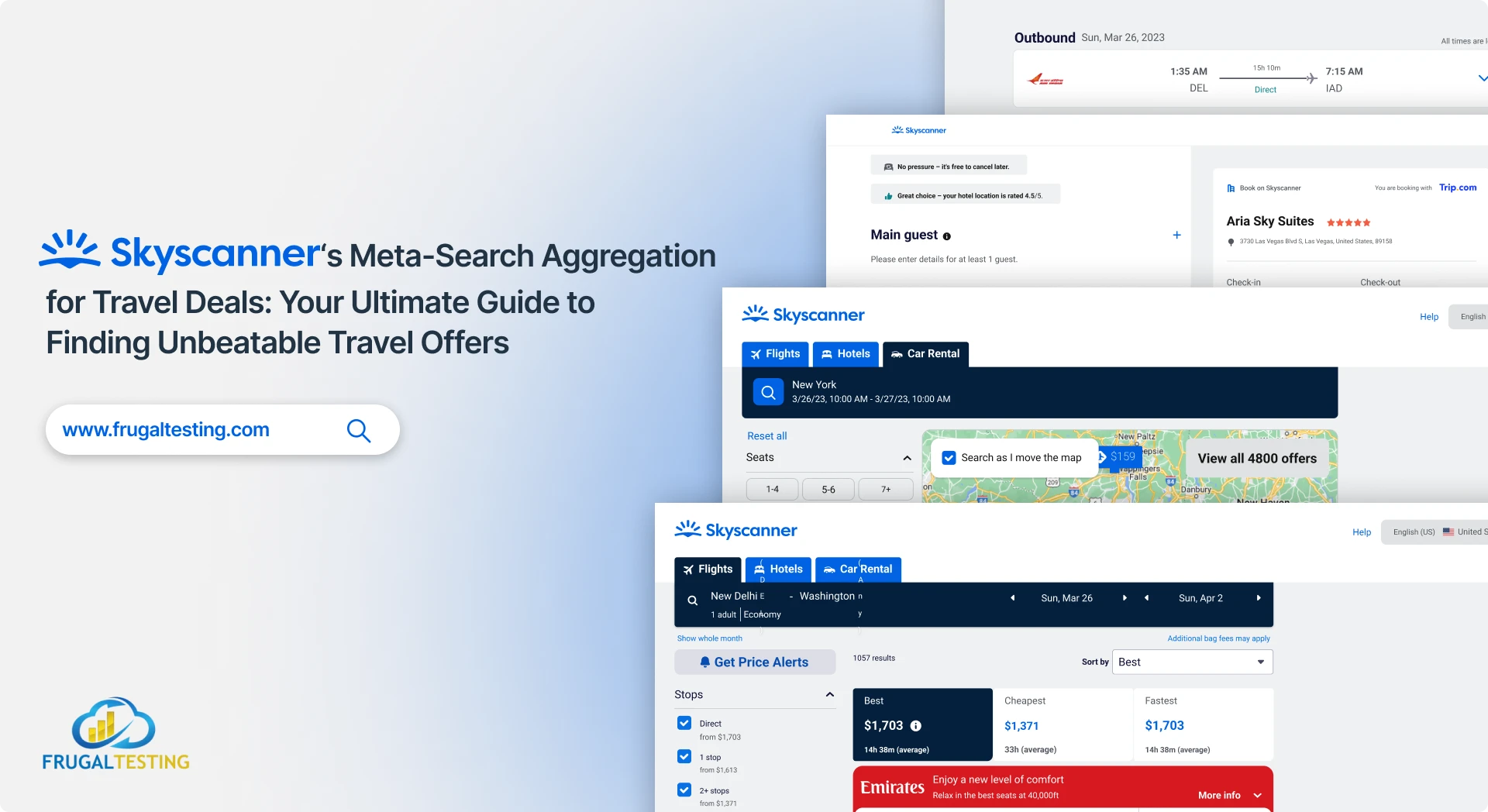In modern software systems, services like APIs, databases, and messaging systems must communicate reliably. Contract testing microservices ensures these interactions follow predefined agreements, preventing integration issues. Unlike end-to-end testing, it focuses on validating contracts between providers and consumers, making it faster and more efficient.
In this guide, we’ll explore the fundamentals of contract testing, API contract testing, and consumer-driven contract testing—helping beginners understand how to implement these practices to build more stable and resilient software integrations. We'll also cover key concepts like contract tests, mock contract setups, contract testing vs integration testing, and popular API contract testing tools, with a detailed focus on Pact testing and Pactflow.

Why You Should Read This Blog:
📌 Seamless Integrations: Ensure compatibility with contract testing microservices.
📌 API Reliability: Prevent breaking changes using consumer-driven contract testing and contract tests.
📌 Key Concepts: Explore Pact testing, Pactflow, and provider-consumer contracts.
📌 Prevent Failures: Mitigate risks with mock contracts and understand contract testing vs integration testing.
📌 Efficient Development: Reduce overhead and improve team collaboration with API contract testing tools.
📌 Optimized Strategies: Implement contract testing pact for stable and resilient integrations.
What is contract testing? A Simple Explanation
Contract testing is a software testing approach that ensures communication between dependent services follows an agreed-upon API contract. It verifies that an API provider and consumer can interact without integration failures, even when developed independently.
Unlike integration tests, which test entire systems, contract testing software focuses on the correctness of interactions between services. It is crucial in microservices architecture to maintain service compatibility and prevent broken contracts.
Popular contract testing tools like Pact Contract Testing, Spring Cloud Contract, and OpenAPI Contract Testing help automate this process, ensuring stable and reliable APIs.
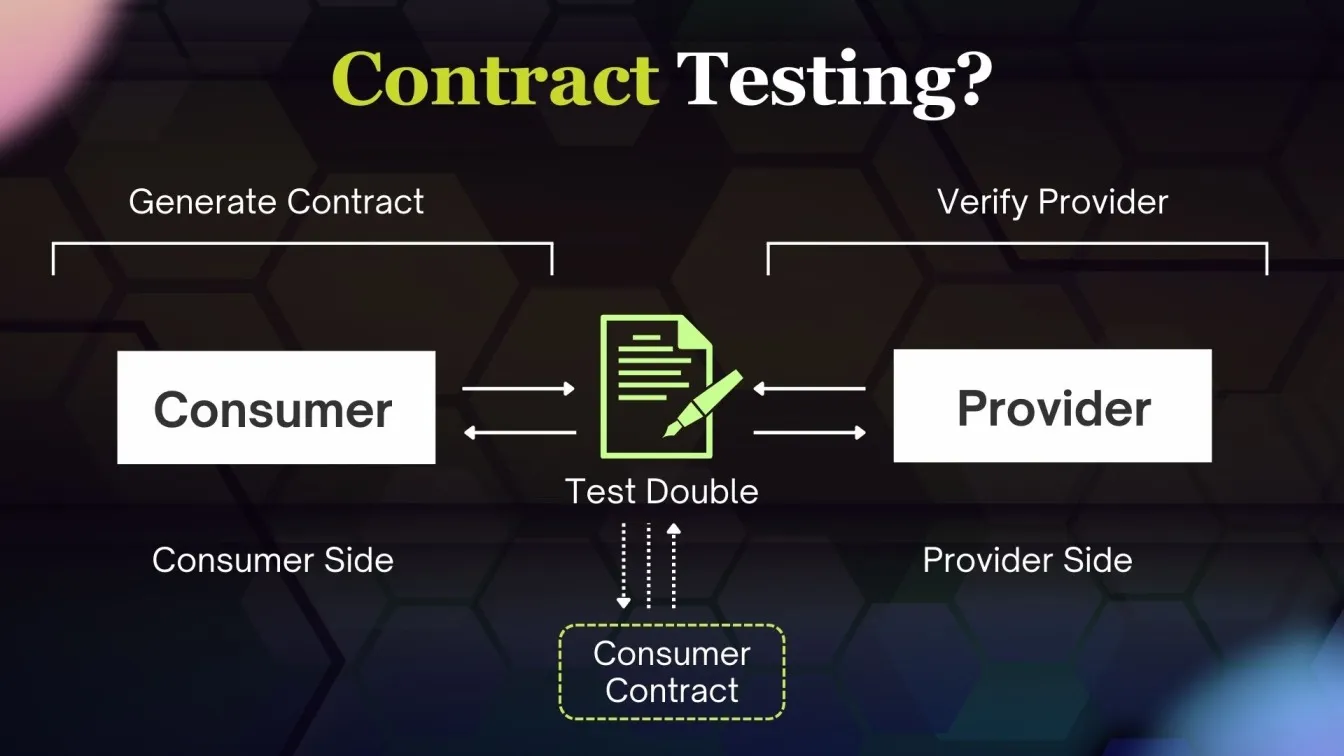
Why is Contract Testing Essential for Modern Software Development?
Modern software development relies on microservices architecture and API-driven systems, where multiple services interact dynamically. Contract Testing ensures that changes in one service do not break others, preventing integration failures and maintaining service compatibility.
Traditional integration tests are slow and complex, whereas contract tests provide a lightweight, efficient way to validate API interactions early in the development process. This enables faster deployments, better scalability, and smoother CI/CD pipelines, making contract testing essential for modern, agile development.
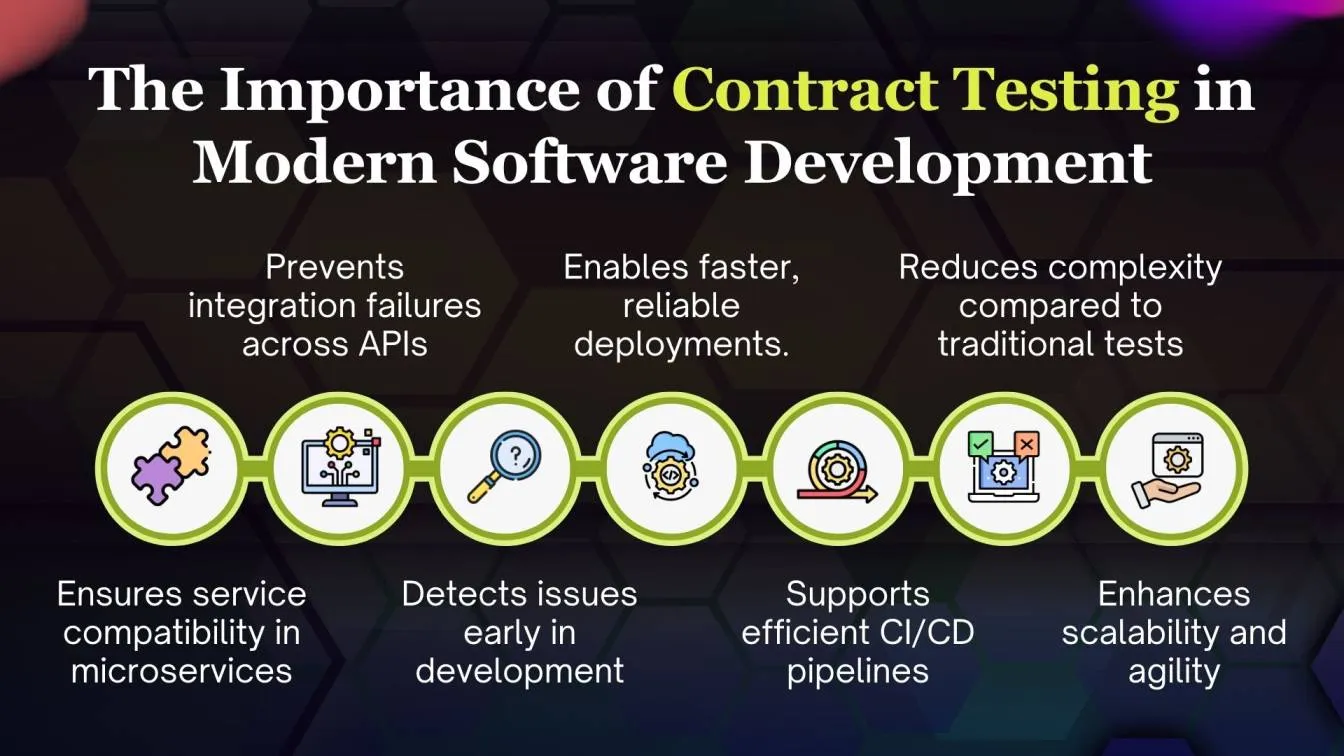
How Does Contract Testing Work? A Step-by-Step Guide
Contract testing ensures seamless communication between services by verifying API interactions against agreed-upon expectations. This guide outlines the key steps, from defining contracts to automating validation and resolving failures.
- Define the Contract – The consumer service specifies its expectations for the provider API service, including API requests, response structure, and response payload.(consumer-driven contract testing)
- Write Consumer Tests – Using tools like Pact Contract Testing or Spring Cloud Contract, the consumer team writes contract tests that generate a contract file detailing expected interactions.
- Verify Provider Compliance – The provider team runs tests against the contract to ensure the API meets the agreed-upon specifications, preventing broken contracts.(contract testing vs integration testing)
- Automate in CI/CD Pipelines – The contract is stored in a contract testing framework (e.g., Pactflow) and validated continuously, enabling faster deployment and reducing compatibility issues.
- Resolve Failures & Iterate – If the provider fails a test, the teams collaborate to update the mock contract and API contract, ensuring smooth service compatibility before deployment.
This structured approach helps teams implement contract testing pact effectively, improving API reliability and minimizing integration risks.
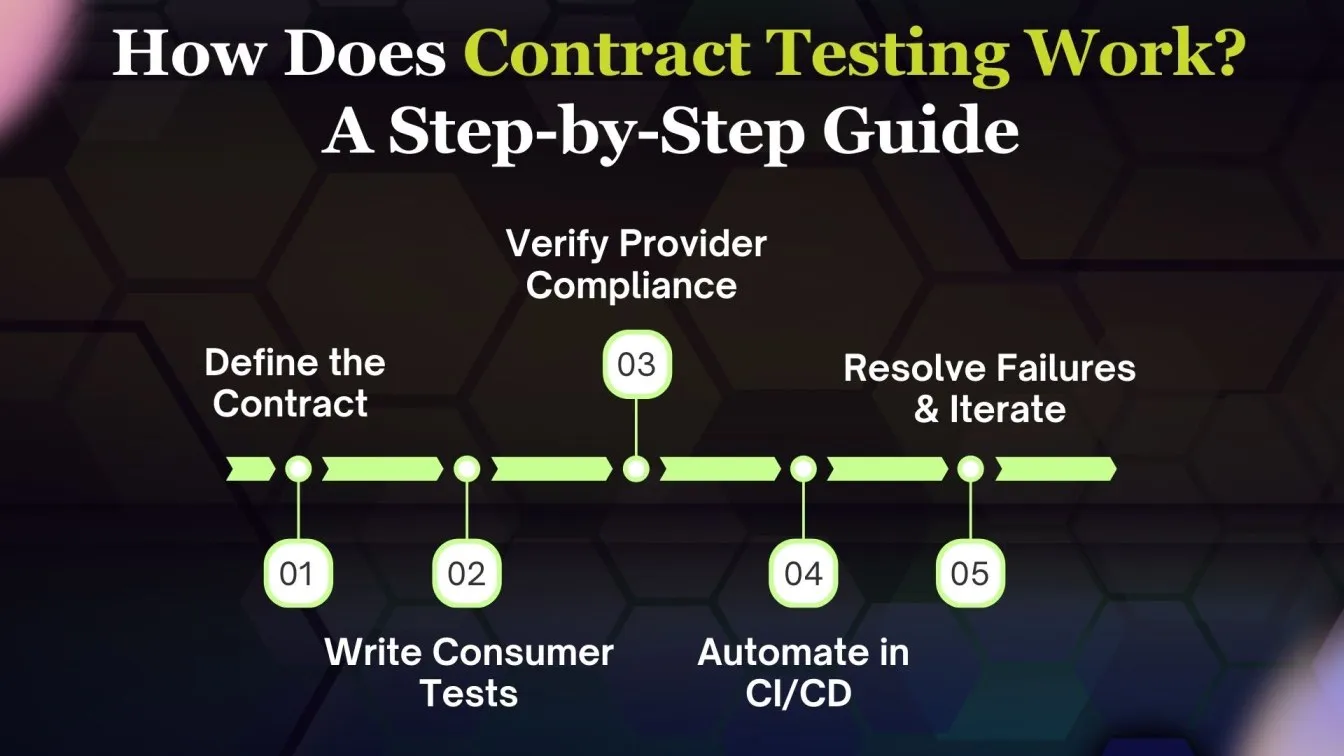
Contract Testing vs. Integration Testing: Key Differences You Must Know
Understanding the differences between Contract Testing and Integration Testing is crucial for choosing the right approach for your project. Below is a table that highlights the key distinctions between these two testing methods:
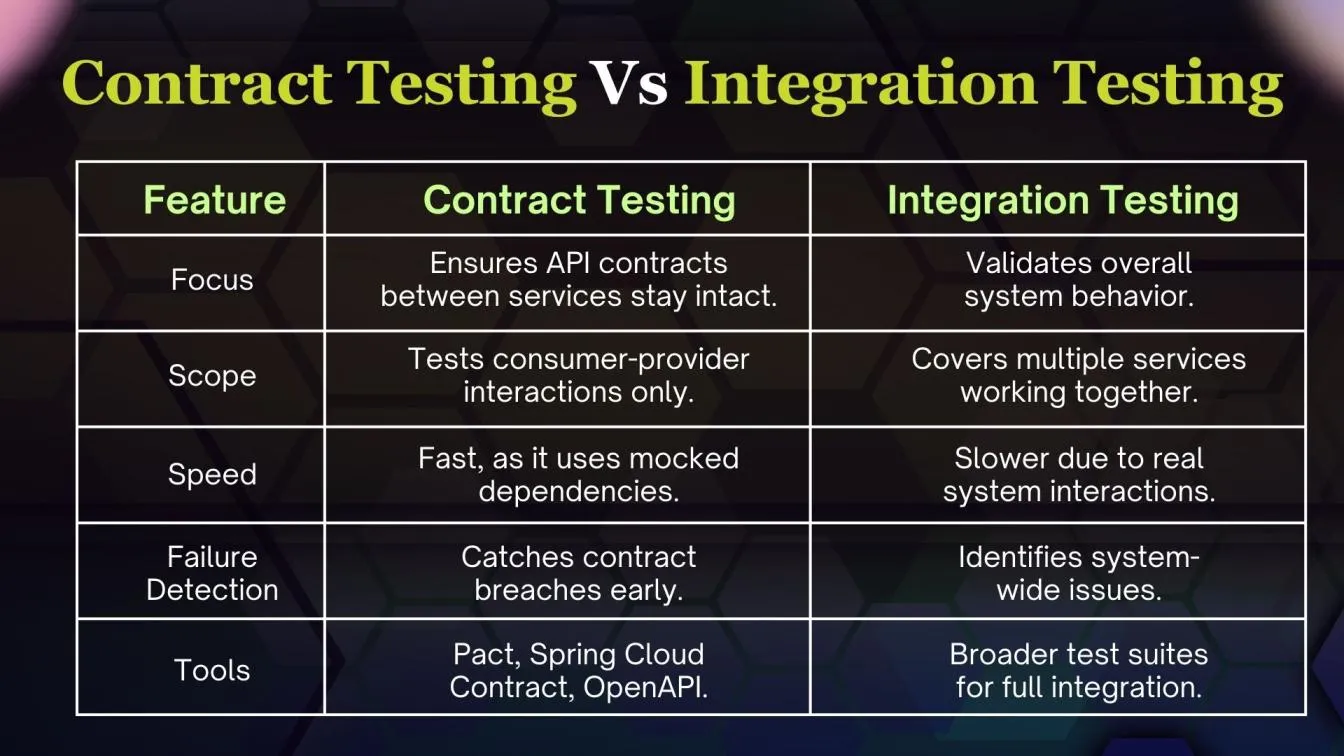
In summary, while Contract Testing ensures that individual service contracts remain intact, Integration Testing validates the overall system behavior. Choosing the right method depends on your development goals, the complexity of your system, and the need for rapid feedback during the development process.
Types of Contract Testing: Provider vs. Consumer-Driven Approaches
Contract testing ensures seamless communication between different services by verifying that they ensure to predefined agreements. It is categorized into the following types:
Types of Contract Testing
1. Provider Contract Testing
- Ensures the provider (API, database, or message broker) adheres to a defined contract test.
- Validates provider responses follow expected formats.
- Prevents breaking changes for consumers.
- Helps in contract testing vs integration testing by focusing on API contract validation rather than full-system tests.
2. Consumer-Driven Contract Testing
- Consumer defines expected interactions, ensuring provider compliance.
- Detects mismatches early, reducing integration failures.
- Ideal for microservices where consumers shape API design.
- Implemented using Pact testing, Pactflow, and other API contract testing tools.
3. Bidirectional Contract Testing
- Validates both provider and consumer-driven contract testing for compatibility.
- Ensures seamless communication between services.
- Useful for teams collaborating on API definitions using mock contract setups.
- Common in contract testing pact implementations.
These approaches help teams implement contract tests efficiently, improving API reliability and reducing integration risks.

Both approaches help prevent integration failures and improve service compatibility, but Consumer-Driven Contract Testing is preferred for dynamic microservices environments.
Benefits of Contract Testing for APIs and Microservices
Contract testing is essential for APIs and microservices as it ensures seamless communication between services. Here are its key benefits:
✅ Prevents Integration Failures – Catches contract mismatches early, avoiding costly system-wide issues.
✅ Faster Development & Deployment – Enables independent consumer and provider teams to work in parallel, speeding up the CI/CD pipeline.
✅ Improves Service Compatibility – Ensures changes in APIs or microservices don’t break dependent services.
✅ Reduces Testing Overhead – Replaces heavy integration tests with lightweight, consumer-driven contract tests, making testing more efficient.
✅ Enhances Microservices Stability – Ensures that interactions between microservices remain consistent, even as services evolve.
✅ Better Collaboration Between Teams – Establishes clear agreed-upon API contracts, improving communication between development teams.
By implementing contract testing, teams can build reliable, scalable, and efficient microservices architectures with faster issue resolution and minimal disruptions.
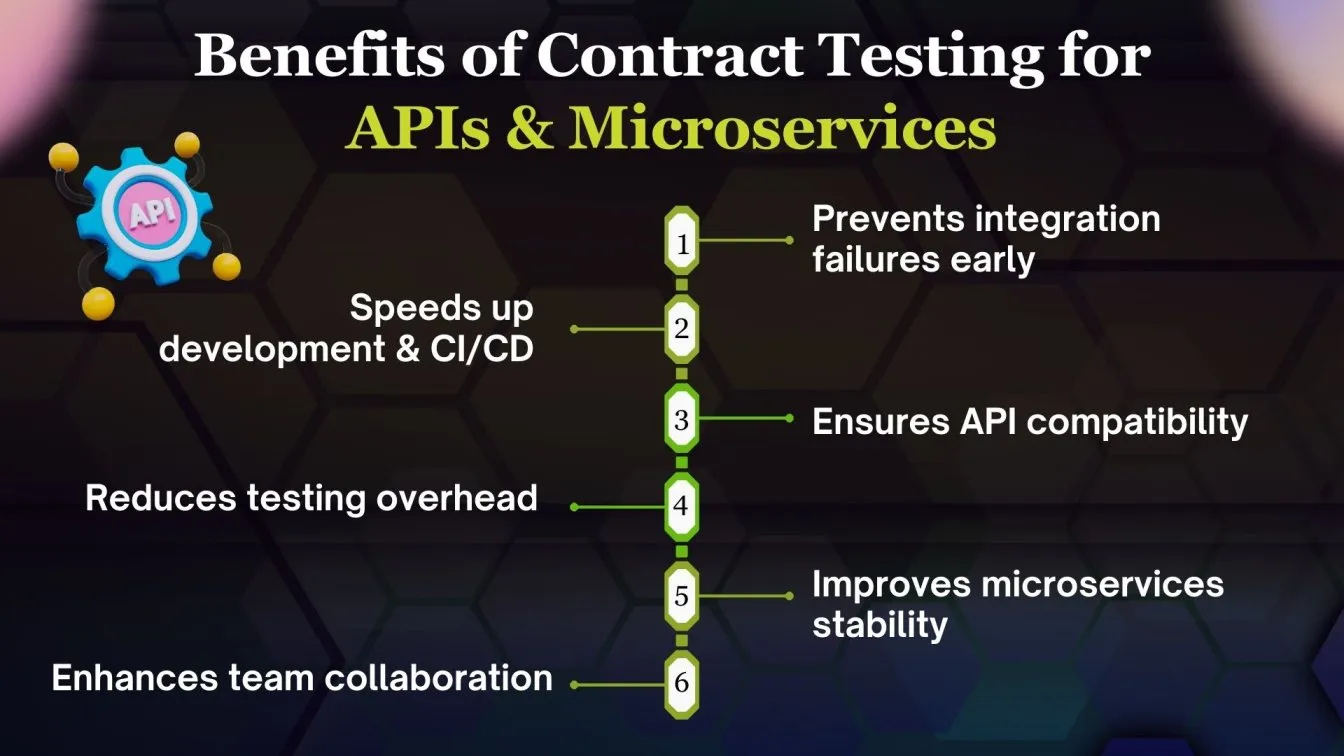
Best Practices for Successful Contract Testing
Contract testing ensures seamless integration between services, but its effectiveness depends on proper implementation. Following best practices helps avoid integration issues, broken contracts, and deployment failures.
Key Best Practices:
✅ Define Clear Contracts – Establish agreed-upon API contracts early to prevent mismatches.
✅ Use Consumer-Driven Testing – Let consumer teams define expected API responses for better alignment.
✅ Automate in CI/CD – Integrate contract testing into CI/CD pipelines for early issue detection.
✅ Version Contracts – Maintain backward compatibility to avoid breaking dependent services.
✅ Mock Dependencies – Use Pact mock servers to test interactions in isolation.
✅ Regularly Validate Contracts – Run tests frequently to catch changes before deployment.
✅ Ensure Team Collaboration – Keep provider and consumer teams aligned to prevent integration failures.
Implementing these best practices guarantees reliable APIs, smooth microservice interactions, and faster deployments.
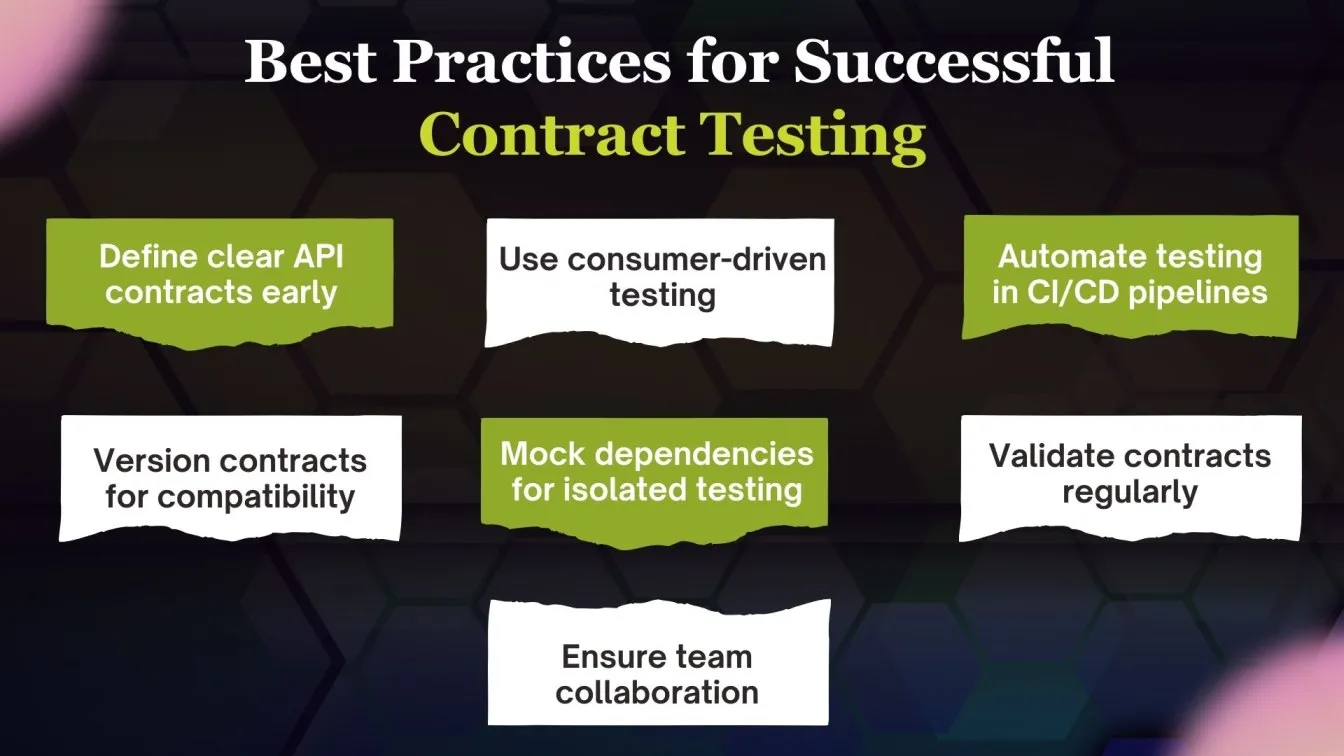
Best Contract Testing Tools: Pact, Spring Cloud Contract & More
Contract testing tools help teams validate API interactions, ensuring seamless communication between providers and consumers. Choosing the right tool depends on your tech stack, testing approach, and integration needs. Below are some of the best tools for contract testing.
Each tool has its strengths. Pact is ideal for consumer-driven contract testing, while Spring Cloud Contract is great for Java applications. By selecting the right tool, teams can reduce integration failures, improve API reliability, and accelerate deployments.
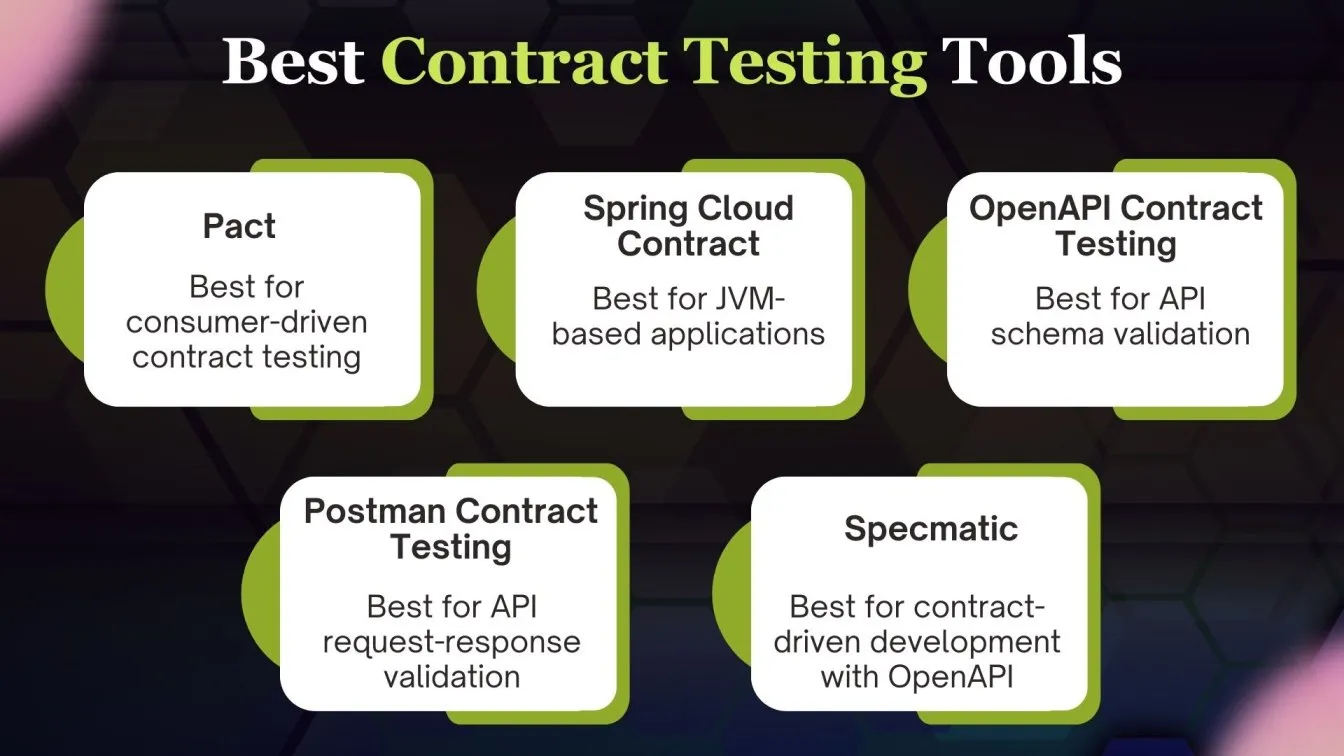
How to Perform API Contract Testing: A Beginner’s Walkthrough
API contract testing ensures that API providers and consumers follow a predefined agreed-upon API contract, preventing integration failures. Below is a step-by-step guide to performing API contract testing:
Step 1: Define the API Contract
- Create an OpenAPI specification or use a contract testing framework like Pact.
- Define request/response formats, including API endpoints, response structure, and payload.
Step 2: Write Consumer Tests
- The consumer team writes tests defining expected API interactions.
- Use Pact Consumer Tests to specify how the API should respond to requests.
Step 3: Generate a Contract File
- The contract file (e.g., Pact JSON) records expected interactions between consumer and provider.
Step 4: Validate the Provider Against the Contract
- The provider team runs contract verification tests using tools like Spring Cloud Contract or Pact.
- If mismatches occur, either the consumer or provider updates their code.
Step 5: Automate in CI/CD
- Integrate contract testing into CI/CD pipelines to catch compatibility issues early.
Step 6: Monitor and Update Contracts
- Regularly update and version contracts to maintain service compatibility in microservices environments.
By following these steps, teams can ensure smooth API communication, reduce integration failures, and accelerate development.
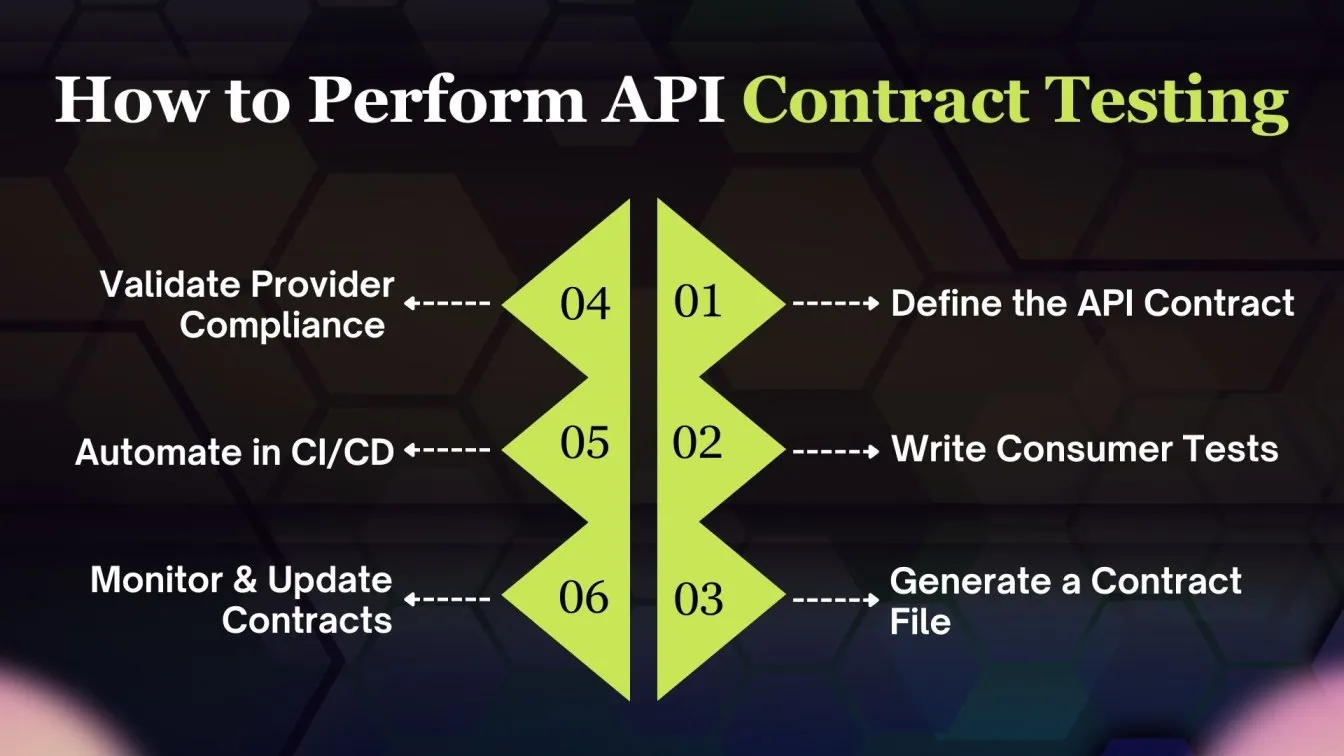
Consumer-Driven Contract Testing: Everything You Need to Know
Consumer-Driven Contract Testing (CDCT) ensures that API providers meet consumer expectations by allowing consumers to define the contract. This approach is crucial in microservice architecture, where services interact dynamically.
How It Works
- Consumer Defines the Contract – The consumer specifies expected API responses using tools like Pact.
- Contract is Shared with the Provider – The contract file (e.g., Pact JSON) is sent to the provider.
- Provider Verifies the Contract – The provider tests the contract against its API implementation.
- Contract Testing in CI/CD – Contracts are automatically verified in the CI/CD pipeline to detect mismatches early.
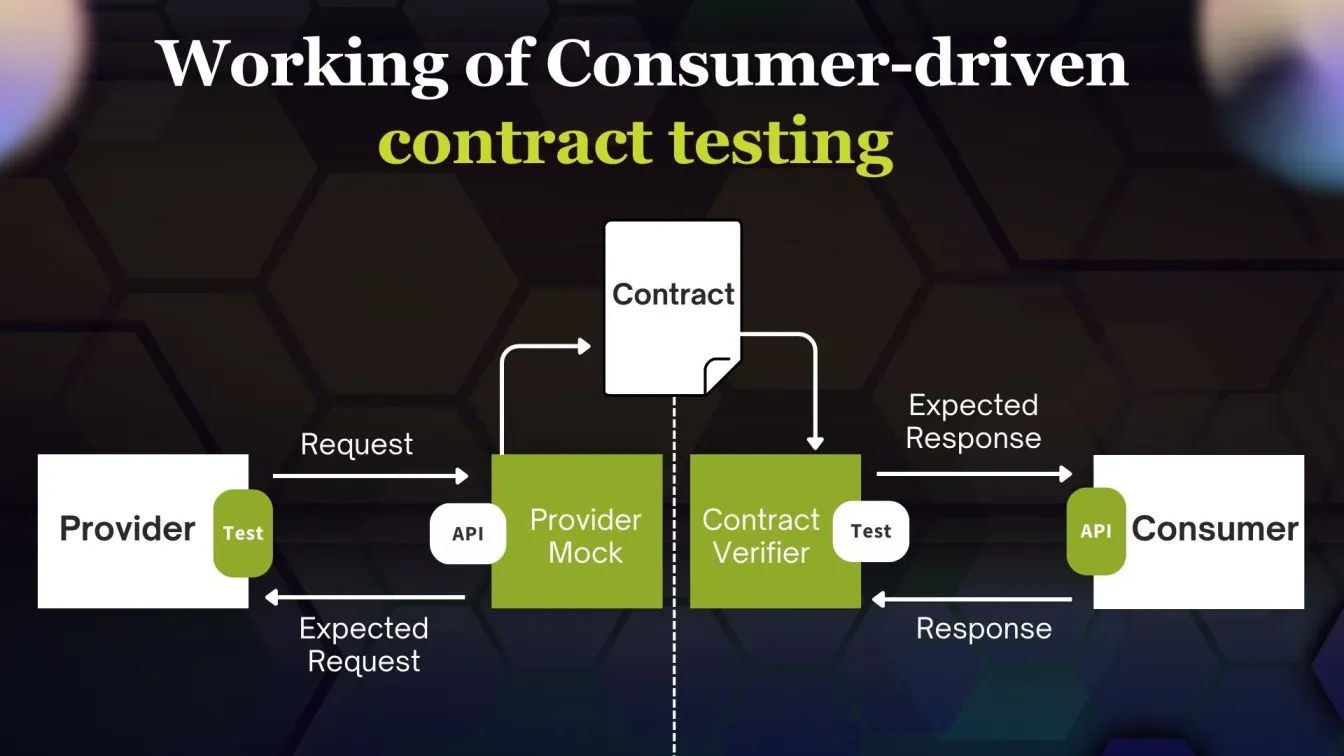
Key Benefits of CDCT
✅ Prevents Integration Failures – Consumers catch issues before deployment.
✅ Faster Development – Teams work independently, improving service compatibility.
✅ Better Collaboration – Ensures agreed-upon API contracts between services.
CDCT is widely used in API contract testing, microservices environments, making it a game-changer for scalable software development.
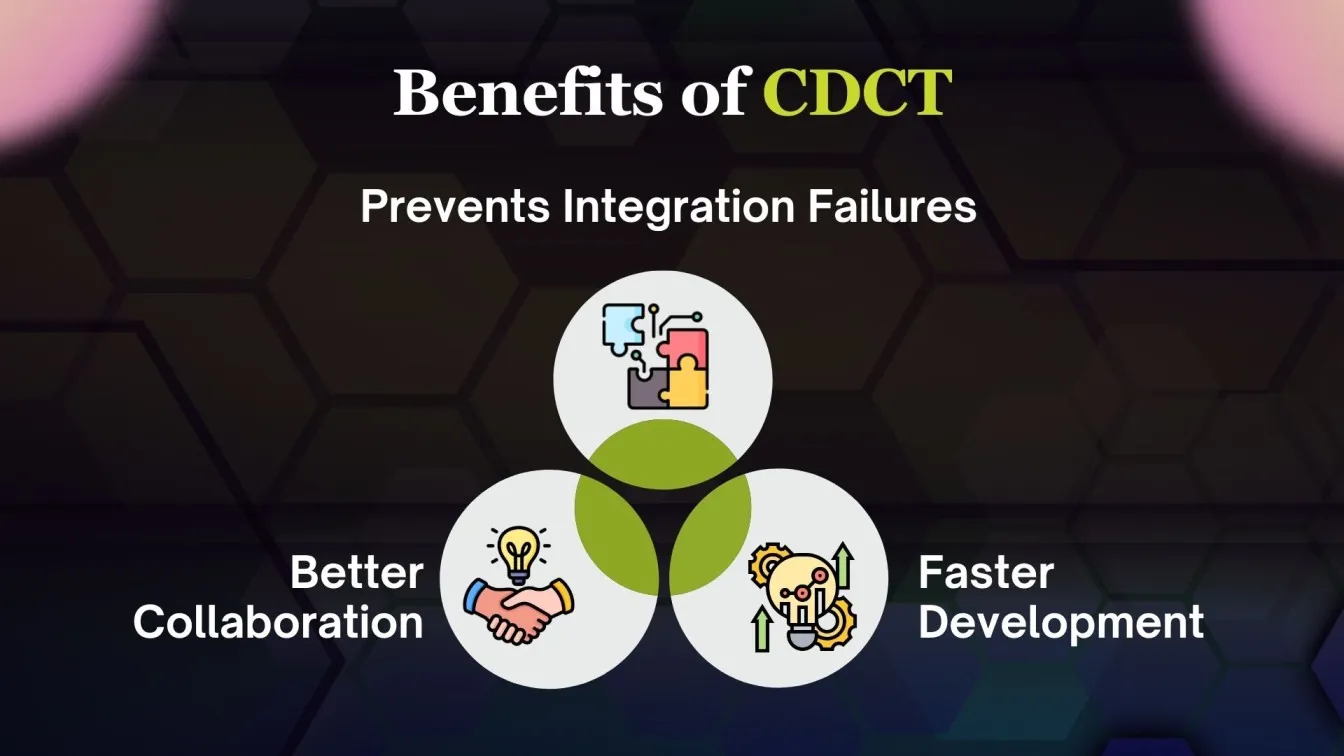
Common Challenges in Contract Testing and How to Solve Them
While contract testing improves API and microservices reliability, teams often face challenges during implementation. Here’s how to overcome them with practical solutions and an example.
By addressing these challenges, teams can ensure smooth API communication, fewer integration failures, and faster deployments.
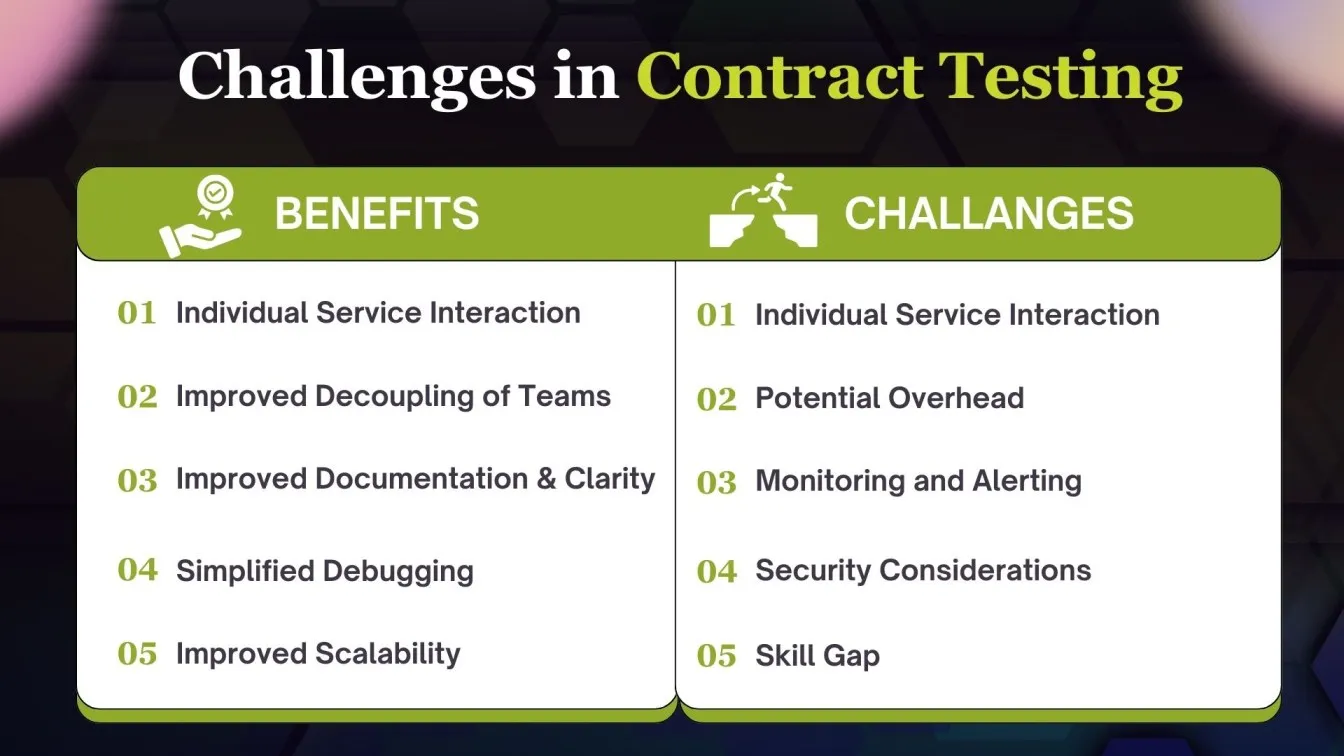
Contract Testing in Microservices: Why It’s a Game-Changer
Contract testing is a game-changer because it ensures microservices remain independent yet compatible, preventing integration failures.
Example: Without Contract Testing
Imagine an e-commerce platform with two microservices:
- Product Service (provides product details)
- Order Service (fetches product details to process orders)
If the Product Service changes a response format (e.g., renaming productPrice to price), the Order Service expecting productPrice will break, causing failed transactions and system downtime.
With Contract Testing
- The Order Service defines a contract specifying it needs productPrice.
- The Product Service runs contract verification before deployment.
- Any mismatch is detected early, and the change is corrected before reaching production.
This prevents unexpected failures, speeds up development, and ensures smooth deployments, making contract testing an essential practice in microservices architecture.
Real-World Examples of Contract Testing in Action
Contract testing is widely used in microservices architectures and API-driven applications to prevent integration failures. Here are some real-world examples:
1. E-Commerce Platform
Scenario: An online store has separate microservices for orders, payments, and inventory.
Challenge: The payment service changes its API response, causing the order service to fail.
Solution: Using Pact contract testing, the order service defines expected responses, ensuring the payment API updates don’t break dependent services.
2. Banking Application
Scenario: A bank uses microservices for user management, transactions, and fraud detection.
Challenge: The fraud detection service needs transaction data, but an update in the transaction service API causes mismatches.
Solution: With consumer-driven contract testing (CDCT), the fraud detection service sets agreed-upon API contracts, preventing broken integrations.
3. CI/CD in SaaS Products
Scenario: A SaaS company with multiple services (billing, authentication, notifications) deploys changes frequently.
Challenge: API changes sometimes break integrations, delaying releases.
Solution: Contract testing in the CI/CD pipeline verifies API compatibility before deployment, enabling faster and safer releases.
These examples show how contract testing ensures stability, accelerates development, and prevents integration failures across industries.
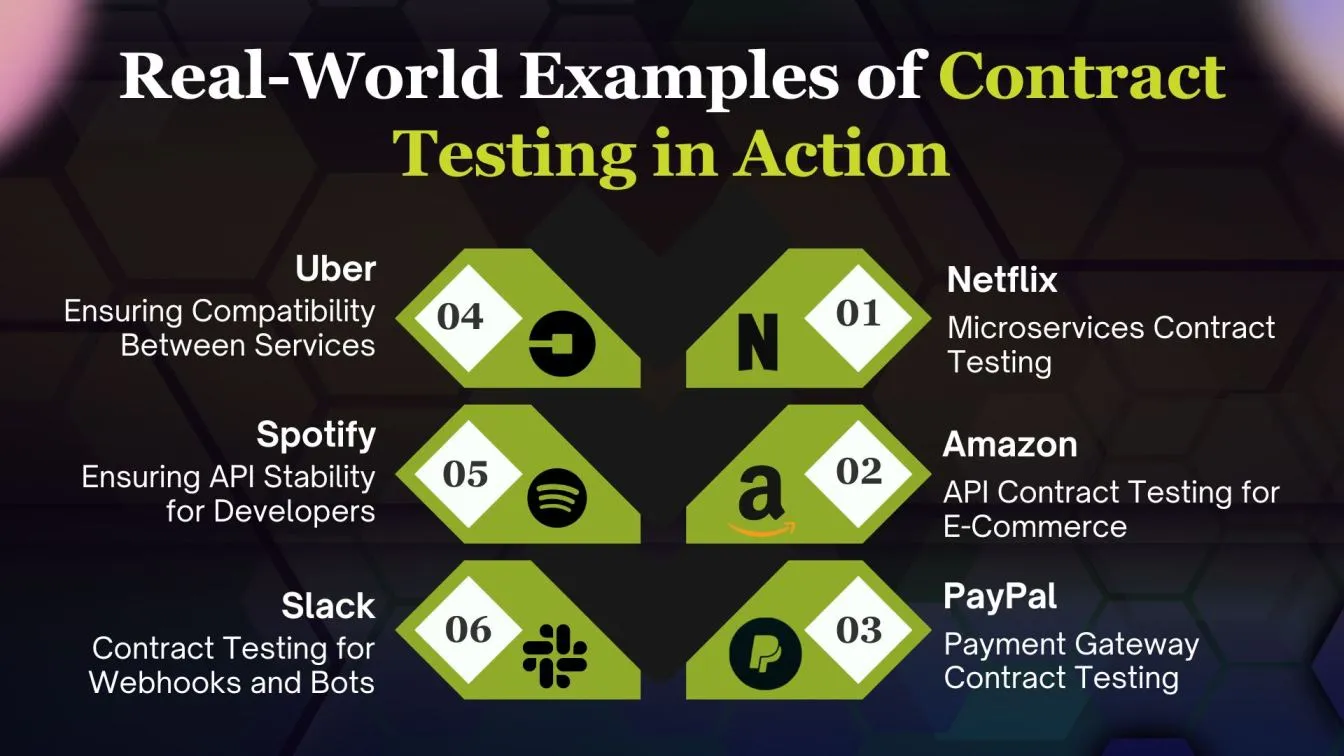
How Contract Testing Enhances CI/CD Pipelines for Faster Deployment
Contract testing plays a crucial role in CI/CD pipelines by ensuring that API changes do not break integrations, leading to faster and safer deployments.
Why Contract Testing is Essential in CI/CD?
🔹 Catches Issues Early – Detects API mismatches before deployment, preventing integration failures.
🔹 Automates Verification – Contracts are tested automatically in the pipeline, eliminating manual testing efforts.
🔹 Speeds Up Releases – Reduces reliance on slow E2E tests, enabling faster iterations.
🔹 Ensures Backward Compatibility – Verifies that API changes do not disrupt existing consumers.
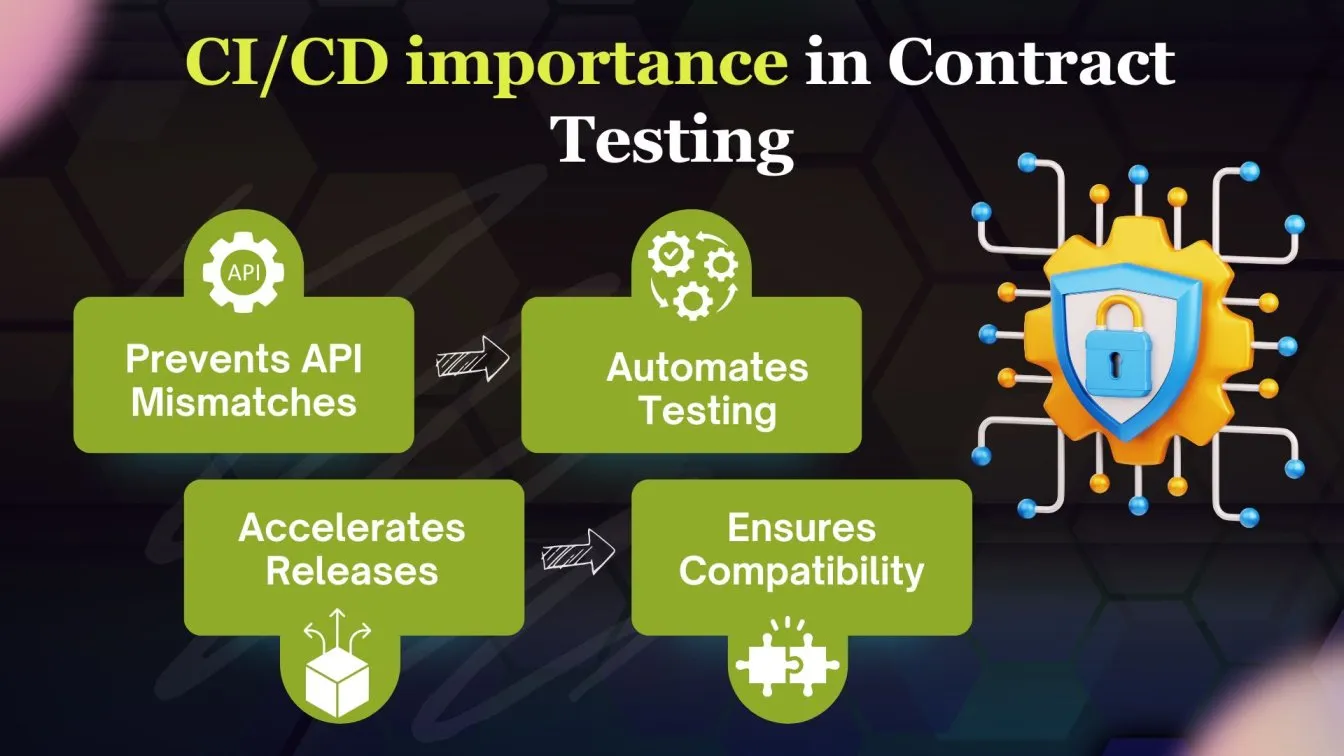
Example: CI/CD Pipeline with Contract Testing
1️⃣ Consumer Service (Frontend) defines an expected contract for API responses.
2️⃣ Provider Service (Backend) runs contract tests in the CI/CD pipeline.
3️⃣ If a mismatch is detected, the deployment is stopped, and the team is alerted.
4️⃣ Fixes are applied before releasing, ensuring error-free deployments.
By integrating contract testing into CI/CD, teams achieve faster releases, fewer production issues, and smoother software delivery.
Final Thoughts: Is Contract Testing Right for Your Project?
Contract testing is a powerful approach for ensuring reliable API integrations, but is it the right fit for your project?
✅ Use Contract Testing If:
- You work with microservices that frequently communicate via APIs.
- Your team follows a CI/CD pipeline and needs automated integration checks.
- API changes often lead to integration failures or broken dependencies.
- You want faster, safer deployments without relying solely on E2E tests.
❌ Might Not Be Necessary If:
- Your system is monolithic with minimal external API dependencies.
- API changes are rare, and manual testing is manageable.
Final Verdict
If your project involves multiple services, frequent API changes, and a need for automation, contract testing is a game-changer. It helps prevent failures, speeds up releases, and ensures smooth integrations, making it an essential practice in modern software development.
People Also Ask
Can contract testing replace end-to-end testing?
No, contract testing complements end-to-end testing but does not replace it. Contract testing ensures that individual services interact correctly, while end-to-end testing verifies the entire system's functionality.
What is API in a smart contract?
An API in a smart contract refers to functions exposed by the contract that external applications or other smart contracts can call to interact with its logic on the blockchain.
How long does it take to get your Pact scores back?
Pact scores are typically available immediately after running contract tests, as they are generated during the test execution process.
Is contract testing the same as API testing?
No, contract testing focuses on validating interactions between services, ensuring they adhere to agreed contracts, while API testing verifies the functionality, performance, and security of APIs.
What is an alternative to Pact?
Alternatives to Pact include tools like Spring Cloud Contract, Hoverfly, WireMock, and Mountebank, which also support contract or service virtualization testing.



%20(1).webp)

%201.webp)

